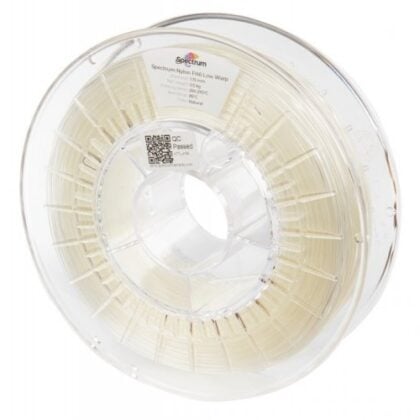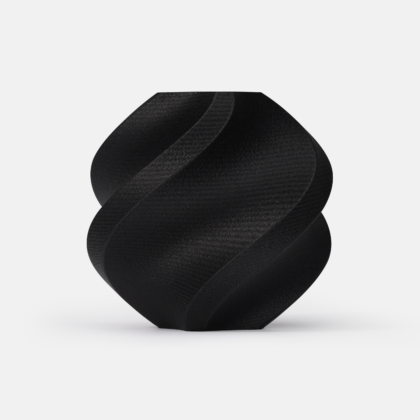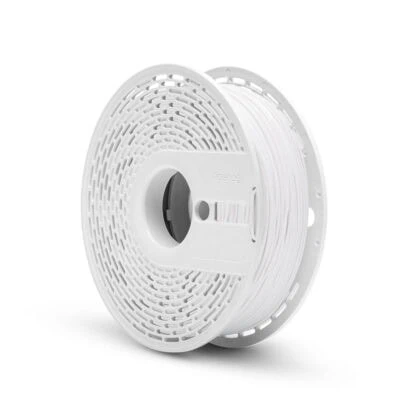PA6 – GF – with spool – Black – Bambu Lab
Features
- Built to last
- Dimensional stability
- Exceptional thermal properties
- Chemical resistance
- Smooth surface in more colours
- Diameter: 1.75 mm +/- 0.03 mm
- 1 kg.
Warnings for use
- Nozzle 0,2 mm is not compatible
- Stainless steel nozzle not recommended
- Compatible with AMS
- AMS lite NOT compatible
- Printers required closed
- Dry before use
Bambu PA6-GF – glass fibre reinforced nylon
Bambu PA6-GF, also known as glass fibre nylon 6, is at the forefront of high performance engineering plastics. It is designed to provide exceptional strength, durability, dimensional stability. PA6-GF is also more cost-effective compared to other high-end engineering filaments.

Designed for long-lasting use
The Bambu PA6-GF is extremely strong and durable thanks to its reinforced glass fibers, making it an ideal choice for prints that need to withstand heavy use and resist bending or breaking.
* Note: The printed part achieves better strength after exposure to moisture.


Dimensional stability
PA6-GF features unparalleled dimensional stability thanks to its glass fiber reinforcement, which minimizes deformation compared to standard PA filaments. Print to exact dimensions, even with the most complex geometries.


Exceptional thermal properties
PA6-GF features a high heat distortion temperature and superior dimensional stability, allowing it to retain its mechanical properties even at elevated temperatures. This makes it ideal for demanding industrial and automotive applications. 
| Type of filament: | PLA Basic | ABS | Normal PA | PC | PA6-GF | PA6-CF | PAHT-CF | PET-CF |
| Heat deflection temperature/℃ (0.45 MPa) | 57 ℃ | 87 ℃ | 89 ℃ | 117 ℃ | 182 ℃ | 186 ℃ | 194 ℃ | 205 ℃ |

Chemical resistance
PA6-GF offers excellent resistance to chemicals, oils and many types of solvents, ensuring long-term performance in challenging environments.


Smooth surface and more colours
Bambu PA6-GF filaments are compatible with the Bambu AMS system and are ready for multi-colour printing. The special surface texture also blurs the layer lines, providing a smooth surface.


RFID for smart printing
All print parameters are embedded in the RFID, which can be read via our AMS (Automatic Material System).
Load and print! No more tedious setup steps.

Comparison of parameters
Learn more about the comparison of different threads in The Bambu Thread Guide >>
| PA6-GF | PA6-CF | PAHT-CF | |
| Composition: | PA6, glass fibre | PA6, carbon fibre | PA12and other long-chain PAs, carbon fibre |
| AMS Compatibility: | YES | BUT | YES |
| Dry before use: | Required | Required | Required |
| Print speed: | < 130 mm/s | < 100 mm/s | < 100 mm/s |
| Printer’s Tip: | Closed | Closed | Closed |
| Durability (impact strength – XY, dry condition): | 27.2 kJ/m² | 40.3 kJ/m² | 57.5 kJ/m² |
| Durability (impact strength – XY, wet condition): | 55.8 kJ/m² | 57.2 kJ/m² | 62.3 kJ/m² |
| Strength (flexural strength – XY, dry state): | 120 MPa | 151 MPa | 125 MPa |
| Strength (flexural strength – XY, wet condition): | 71 MPa | 95 MPa | 115 MPa |
| Layer strength (flexural strength – Z, dry state): | 51 MPa | 80 MPa | 61 MPa |
| Layer strength (flexural strength – Z, wet condition): | 33 MPa | 45 MPa | 49 MPa |
| Stiffness (flexural modulus – XY, dry state): | 3670 MPa | 5460 MPa | 4230 MPa |
| Stiffness (flexural modulus – XY, wet condition): | 2120 MPa | 3560 MPa | 3640 MPa |
| Layer adhesion (impact strength – Z, dry state): | 4.1 kJ/m² | 15.5 kJ/m² | 13.3 kJ/m² |
| Heat resistance(HDT, 0.45 MPa, dry state): | 182 ℃ | 186 ℃ | 194 ℃ |
| Absorption rate of saturated water/%(25 °C, 55% RH): | 2.56 | 2.35 | 0.88 |
Compatibility with accessories
| Recommended: | Not recommended: |
|
| Backing: | Smooth PEI backing, Textured PEI backing | SuperTack Cool Pad |
| Hotend: | Hotend with hardened steel nozzle 0.4mm / 0.6mm (recommended ) / 0.8mm | Hotend with stainless steel nozzle (All sizes) |
| Glue: | Bambu stick glue / EcoFixy glue | Bambu liquid glue |
| AMS & AMS lite | AMS | AMS lite |
| Recommended print settings: | |
| Drying settings before printing: | 80 °C, 8 – 12 h. |
| Printing and maintaining the humidity of the container: | < 20% RH (Sealed, with desiccant) |
| Nozzle temperature: | 260 – 290 °C |
| Bed temperature (with adhesive) | 80 – 100 °C |
| Print speed: | < 130 mm/s |
| Physical properties: | |
| Density: | 1.14 g/cm³ |
| Vicat softening temperature | 210 °C |
| Heat deviation temperature | 182 °C |
| Melting temperature: | 219 °C |
| Melting index: | 9.0 ± 0.8 g/10 min. |
| Mechanical properties: | |
| Tensile strength: | 75 ± 6 MPa |
| Fracture extension rate: | 3.9 ± 0.8 % |
| Bending module: | 3670 ± 140 MPa |
| Bending force: | 120 ± 6 MPa |
| Impact force: | 27.2 ± 2.2 kJ/m² |
Printing tips
– Bambu PA6-GF needs proper drying before printing: the recommended drying temperature is 80℃ for 8 to 12 hours in a shock dryer or 90 to 100℃ for 10 to 12 hours on a heat bed. (Do not exceed 100℃ because the spool may deform or even melt). For more details, please refer to: WIKI engineering printing tips.
– To prevent moisture absorption by the filaments, it is recommended that an airtight storage container with desiccant be used during printing. For more details, please see: WIKI Engineering Printing Tips.
– To minimize distortion, avoid printing models with large sizes and high fill densities. Use enclosed printers and make sure the build plate is properly applied with adhesive to better bond the print before printing.
– For better printing results and more details, please see: WIKI Engineering Printing Tips.
Tips for post-processing
– We recommend that you remove the support structures within 2 hours of printing to prevent them from sticking after absorbing moisture. If sticking occurs, dry the model to facilitate removal.
– Placing the printed part in a convection oven set at a temperature between 80 and 130 degrees Celsius for 5 to 12 hours can further improve the strength and hardness of the print. Note: The effectiveness of this process depends on the structure, size and conditions of the printed pattern. Some patterns may warp or deform after annealing. For more details, please refer to Working after printing is complete in WIKI.
What’s in the box?


















There are no reviews yet.